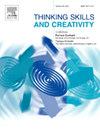概念映射任务中高、低成就群体知识构建过程的差异:多视角证据
IF 4.5
2区 教育学
Q1 Social Sciences
引用次数: 0
摘要
协作学习对于帮助学生理解知识和共同构建知识具有重要意义。许多研究使用概念图,一种可视化工具,来帮助这个过程。研究三人或三人以上的群体构建知识的方式以及将隐性生理数据与显性数据结合起来是至关重要的。在这项研究中,我们结合内容分析、有序网络分析(ONA)和基于脑电图(EEG)的超扫描技术,分析了28个参与协同概念映射任务的高成就组和低成就组的三联征数据。频率统计结果显示,低成就组在调节维度的个体层面监测和适应行为频率显著高于高成就组。ONA结果进一步说明了基于频率分析的知识转移顺序。高成就群体的认知模式呈现出从群体认知水平开始,到同伴认知水平,再到群体调节水平,最后回到群体认知水平的循环。低成就组的认知模式也表现出方向性,从群体调节水平到个体认知水平再到群体认知水平。从内隐的角度来看,高成就组的θ波带和颞顶叶区域表现出更大的脑间同步。另一方面,低成就组的同步性相对较低。他们的共识只是表面的,集中在通过监管和思想整合确保每个人都参与来完成任务。我们的研究结果可以帮助教师和教学设计师根据学习者在协作概念映射任务中的认知模式差异制定量身定制的干预措施。本文章由计算机程序翻译,如有差异,请以英文原文为准。
Differences in the collaborative knowledge construction process between high- and low-achievement groups in a collaborative concept mapping task: Evidence from multiple perspectives
Collaborative learning is important for assisting students in knowledge understanding and knowledge co-construction. Many studies use concept maps, a visualized tool, to aid in this process. It is crucial to look into the ways that groups of three or more people construct knowledge and to combine implicit physiological data with explicit data. In this study, we combined content analysis, ordered network analysis (ONA), and hyperscanning technology based on electroencephalograms (EEG) to analyze the data of 28 triads of high- and low-achievement groups that participated in collaborative concept mapping tasks. The frequency statistics showed that the low-achievement groups have significantly higher monitoring and adapting behavior frequencies at the individual level in the regulation dimension than the high-achievement groups. The ONA results further illustrated the sequence of knowledge transfer based on the frequency analysis. The cognitive patterns of high-achievement groups showed a cycle that began at the group level of cognition, moved to the peer level of cognition, then to the group level of regulation, and ultimately returned to the group level of cognition. The low-achievement groups' cognitive patterns also exhibited directionality, moving from the group level of regulation to the individual level of cognition and to the group level of cognition. From the implicit perspective, the theta band and temporal-parietal regions showed greater inter-brain synchrony in the high-achievement groups. Low-achievement groups, on the other hand, had comparatively lower synchrony. Their consensus was only superficial and concentrated on ensuring that everyone participated through regulation and thought integration to finish the task. Our study's findings can help teachers and instructional designers develop tailored interventions based on differences in learners' cognitive patterns during collaborative concept mapping tasks.
求助全文
通过发布文献求助,成功后即可免费获取论文全文。
去求助
来源期刊

Thinking Skills and Creativity
EDUCATION & EDUCATIONAL RESEARCH-
CiteScore
6.40
自引率
16.20%
发文量
172
审稿时长
76 days
期刊介绍:
Thinking Skills and Creativity is a new journal providing a peer-reviewed forum for communication and debate for the community of researchers interested in teaching for thinking and creativity. Papers may represent a variety of theoretical perspectives and methodological approaches and may relate to any age level in a diversity of settings: formal and informal, education and work-based.
 求助内容:
求助内容: 应助结果提醒方式:
应助结果提醒方式:


